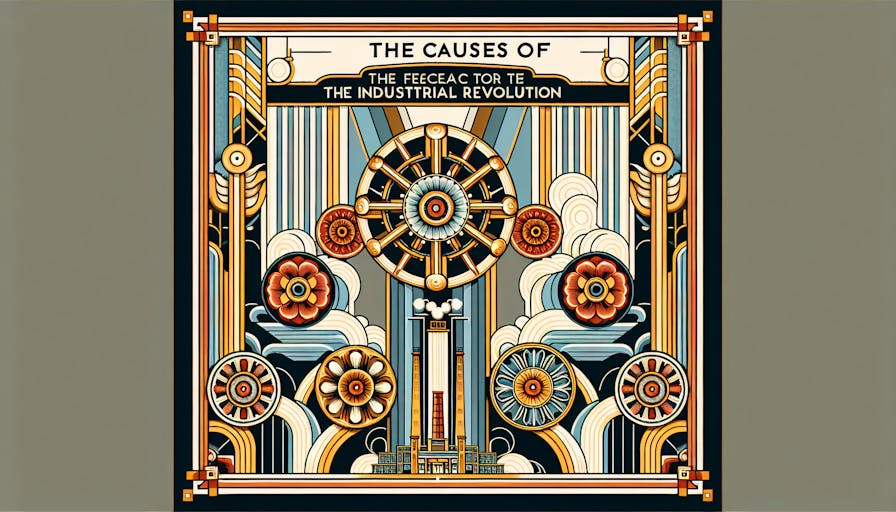Table of Contents
Understanding the Causes of the Industrial Revolution
To grasp the significance and impact of the Industrial Revolution, it is essential to gain an understanding of its definition, overview, and historical context.
Definition and Overview
The Industrial Revolution refers to a period of profound transformation that occurred in Britain in the late 18th century and subsequently spread across the world. It marked a significant shift in the way goods were produced, leading to a rapid transition from manual labor to machine-based manufacturing processes. This revolution brought about a series of technological, economic, and social changes that reshaped societies and laid the foundation for modern industrialized nations.
The term “industrial revolution” is often used to describe the transition from agrarian societies to industrialized ones. It involved advancements in various industries, such as textiles, iron production, transportation, and agriculture. The industrialization process led to a significant increase in production efficiency, the development of new technologies, and the emergence of new economic systems.
Historical Context
The Industrial Revolution emerged in Britain, and its causes are multifaceted and complex. Several factors contributed to its onset and rapid growth. These factors include advancements in agriculture, population growth, technological innovations, access to capital, and the accumulation of wealth from trade.
Britain possessed abundant natural resources, including coal and iron ore, which were crucial for industrialization. Additionally, the country experienced a period of rapid population growth, which created a large labor force and a growing market for goods. Technological advancements, such as the invention of the steam engine and the development of textile machinery, played a pivotal role in driving industrialization forward.
The accumulation of capital, fueled by the profits from trade and colonial ventures, provided the necessary resources for investment in new industries and infrastructure. These factors, combined with social changes and a desire for progress, set the stage for the Industrial Revolution to take hold in Britain.
The Industrial Revolution in Britain served as a catalyst for change, eventually spreading to other parts of the world, including the United States. This period of transformation, often referred to as the First Industrial Revolution, reshaped societies and economies, leading to the rise of urban centers, the growth of factory systems, and significant shifts in labor conditions.
By understanding the definition, overview, and historical context of the Industrial Revolution, we can gain a deeper appreciation for the causes, impact, and key innovations that shaped this pivotal period in history. To explore the causes in detail, refer to our article on the causes of the industrial revolution. To delve into the impact of the Industrial Revolution, including economic transformation and social changes, visit our article on the effects of the industrial revolution. For an examination of the working conditions during this period, see our article on industrial revolution working conditions.
Causes of the Industrial Revolution
The Industrial Revolution, a period of significant economic and social change, was driven by various factors. These causes laid the foundation for the rapid industrialization that transformed societies and economies during this time.
Technological Advancements
Technological advancements played a crucial role in propelling the Industrial Revolution forward. Innovations such as the steam engine, textile machinery, and iron production revolutionized manufacturing processes, leading to increased productivity and efficiency. The steam engine, in particular, powered factories, enabled the mechanization of various industries, and facilitated the development of transportation systems (Britannica).
Population Growth
The increase in population during the Industrial Revolution was a significant catalyst for change. The shift from rural living to cities resulted in a greater demand for goods and services. This surge in population created a labor force that fueled the expansion of industries and the growth of urban centers.
Access to Capital
Access to capital was another critical factor in driving the Industrial Revolution. The availability of financial resources allowed entrepreneurs to invest in new technologies, build factories, and finance infrastructure development. Capital accumulation and the emergence of early forms of capitalism played a pivotal role in facilitating industrial growth.
Agricultural Innovations
Advancements in agricultural practices and technology also contributed to the Causes of the Industrial Revolution. Innovations such as the enclosure movement and crop rotation improved agricultural productivity, leading to increased food production and surplus labor. This surplus workforce, freed from agricultural labor, could then be absorbed by the expanding industrial sector (Britannica).
Trade and Colonization
Global trade and colonization played a significant role in driving the Causes of the Industrial Revolution. The growth of international trade, facilitated by colonial expansion and the discovery of new resources, created new markets and sources of raw materials. This, in turn, stimulated industrial growth and provided the necessary resources for manufacturing and production (Britannica).
Understanding the causes of the Industrial Revolution helps us grasp the complex factors that brought about this transformative period in history. From technological advancements and population growth to access to capital, agricultural innovations, and the impact of trade and colonization, these causes collectively shaped the industrial landscape and set the stage for the profound changes that followed. To explore the effects of the Industrial Revolution, visit our article on the effects of the industrial revolution.
Impact of the Industrial Revolution
The Industrial Revolution, which occurred from 1750 to 1900, had profound impacts on society, transforming economies, labor practices, and social structures, and laying the foundation for modern industrialized nations. Let’s explore some of the key effects of the Industrial Revolution.
Economic Transformation
One of the most significant impacts of the Industrial Revolution was the economic transformation it brought about. The introduction of new technologies and the mechanization of production processes led to increased efficiency and productivity in various industries. This resulted in a significant expansion of industrial output, leading to economic growth and the accumulation of wealth.
The Industrial Revolution also brought about a shift from agrarian-based economies to industrial economies. Traditional cottage industries were replaced by large-scale factories and industrial production. This shift led to the rise of capitalism, as entrepreneurs and investors sought to capitalize on the opportunities presented by the new industrial era. The growth of capitalism fostered economic competition, innovation, and the accumulation of capital needed to finance factories, machinery, and infrastructure (Study.com).
Social Changes
The Industrial Revolution had far-reaching social impacts, reshaping societies across the globe. One of the significant social changes was the rise of urbanization. As industrial centers developed, people migrated from rural areas to cities in search of employment opportunities in factories. This rapid urbanization resulted in the growth of cities and the emergence of densely populated urban areas.
With the rise of factories and the shift from home-based production to factory production, a new social structure emerged. The working class, consisting of factory workers, developed alongside the capitalist class. This division between the working class and the capitalist class led to significant social and economic inequalities. The working class faced challenging working conditions, long hours, low wages, and poor living conditions. These social disparities and the emergence of a working class laid the foundation for social and labor movements that aimed to improve the lives of workers (Britannica).
Urbanization and Factory System
The Industrial Revolution brought about a shift from rural agrarian societies to urban industrial societies. The growth of factories and industries in urban areas attracted people from rural areas, leading to rapid urbanization. This urban migration resulted in overcrowded cities, inadequate housing, and poor sanitation conditions. However, cities also became centers of innovation, culture, and economic activity.
The factory system became a central feature of the Industrial Revolution. Previously, production was primarily carried out in homes or small workshops. However, with the advent of factories, production processes were consolidated into large-scale facilities. This factory system allowed for increased production efficiency and specialization of labor. However, it also led to the separation of workers from their means of production, as they became dependent on factory owners for employment.
Labor Conditions
The working conditions during the Industrial Revolution were often harsh and dangerous, particularly for factory workers. Long working hours, ranging from 12 to 16 hours per day, were common. Workers, including women and children, often faced dangerous working conditions, with little to no safety regulations in place. The lack of protective measures resulted in frequent accidents and injuries.
Workers also faced poor wages and minimal job security. The working class struggled to improve their living conditions and secure better rights and protections. As a response to these challenging conditions, labor movements emerged, advocating for workers’ rights, improved working conditions, and fair wages.
The impact of the Industrial Revolution on labor conditions and the subsequent labor movements paved the way for the development of labor laws and regulations, aiming to protect workers and improve their quality of life.
The Industrial Revolution brought about significant changes in society, economy, and labor practices. The economic transformation, social changes, urbanization, and labor conditions shaped the course of history and laid the foundation for the modern world.
Key Innovations of the Industrial Revolution
The Industrial Revolution brought about significant technological advancements that transformed various industries and propelled economic growth. Key innovations during this period played a pivotal role in shaping the course of history. Let’s explore some of these innovations: the steam engine, textile machinery, iron production, and transportation infrastructure.
Steam Engine
The invention of the steam engine, particularly James Watt’s improvements to its efficiency, stands as one of the most critical innovations of the Industrial Revolution. The steam engine played a crucial role in powering various industries across Britain, such as flour mills, cotton mills, iron works, distilleries, waterworks, and canals (History.com). This revolutionary technology facilitated the widespread use of steam power and led to an increased demand for coal to fuel factories, railroads, and steamships. The steam engine’s impact on industrialization was profound, driving unprecedented productivity and enabling the transportation of goods and people over long distances.
Textile Machinery
The textile industry experienced a revolution with the introduction of various innovative machines. Inventions like the spinning jenny, the flying shuttle, the water frame, and the power loom transformed the British textile industry in the mid-18th century (History.com). These machines mechanized the production of cloth, significantly increasing efficiency and reducing the reliance on manual labor. By automating processes, textile factories could meet the growing demand for textiles both domestically and in the British Empire’s colonies. This shift in textile production revolutionized the entire industry, making cloth production faster, more cost-effective, and more accessible.
Iron Production
The British iron industry also witnessed significant advancements during the Industrial Revolution. Innovations in iron production, such as smelting iron ore with coke instead of charcoal, transformed the industry’s capabilities. This technique, which was cheaper and produced higher-quality iron, facilitated the expansion of Britain’s iron and steel production. The increased capacity and efficiency of iron production were driven by the growing demand for iron and steel due to events like the Napoleonic Wars and the rapid development of the railroad industry.
Transportation Infrastructure
The Industrial Revolution brought about a revolution in transportation as well. In the early 19th century, the introduction of steam-powered locomotives and steamboats revolutionized the movement of goods and people. Richard Trevithick’s steam-powered locomotive, introduced in the early 19th century, transformed land transportation (History.com). Steam locomotives started transporting freight and passengers between industrial hubs in Britain. By 1830, steam-powered boats and ships were widely used for transporting goods along rivers, canals, and across the Atlantic. These advancements in transportation infrastructure facilitated the growth of trade, enabled the efficient movement of raw materials and finished products, and further fueled industrialization.
The key innovations of the Industrial Revolution, including the steam engine, textile machinery, iron production techniques, and transportation infrastructure, laid the foundation for the profound changes that occurred during this period. These innovations fundamentally transformed industries, revolutionized production processes, and propelled economic growth. It’s through these advancements that the Industrial Revolution shaped the world we know today.
Global Spread of the Industrial Revolution
The Industrial Revolution, which began in Britain in the late 18th century, soon spread to other countries, transforming societies and economies across the globe. In this section, we will explore the diffusion of the Industrial Revolution to other countries and its impact on industrialization in the United States.
Diffusion to Other Countries
After its emergence in Britain, the Industrial Revolution gradually spread to other parts of Europe and North America. The initial diffusion was facilitated by factors such as the availability of resources, advancements in technology, and the growth of international trade due to colonization and the discovery of new resources (Britannica). Countries like France, Germany, and Belgium experienced industrialization and witnessed the growth of industries like textiles, iron, and coal mining.
The diffusion of the Industrial Revolution was not limited to Europe. It also reached countries like the United States, where industrialization played a significant role in its economic development. The United States underwent its own industrial revolution, characterized by the growth of industries, urbanization, and technological advancements.
Industrialization in the United States
Industrialization in the United States began in the early 19th century and was influenced by the advancements and innovations of the Industrial Revolution in Britain. The United States had abundant natural resources, such as coal, iron ore, and vast expanses of land, which provided the foundations for industrial growth.
One of the key industries that drove industrialization in the United States was textiles. The mechanization of textile production, particularly the invention of the cotton gin by Eli Whitney in 1793, revolutionized cotton production and led to the establishment of cotton mills across the country. Additionally, the development of transportation infrastructure, including the expansion of canals and the introduction of steam-powered locomotives, facilitated the movement of goods and raw materials, further supporting industrial growth (History.com).
Industrialization in the United States expanded rapidly in the 19th century, with the growth of industries such as steel, oil, and manufacturing. Innovations like the Bessemer process for mass steel production and the assembly line revolutionized manufacturing processes, leading to increased productivity and economic development. The United States emerged as a global industrial power, shaping its economy and society in profound ways.
The diffusion of the Industrial Revolution to other countries and its impact on industrialization in the United States marked a significant turning point in world history. The economic and social changes brought about by industrialization continue to shape our modern world, with the legacy of the Industrial Revolution still evident in our industrial systems, technologies, and urban landscapes.
In the next section, we will explore the key innovations that emerged during the Industrial Revolution, including the steam engine, textile machinery, iron production, and transportation infrastructure.
Key Innovations of the Industrial Revolution
During the Industrial Revolution, numerous technological advancements emerged, revolutionizing various industries and driving economic growth. In this section, we will explore four key innovations that played a significant role in shaping the Industrial Revolution: the steam engine, textile machinery, iron production, and transportation infrastructure.
Steam Engine
One of the most pivotal inventions of the Industrial Revolution was the steam engine. In the early 1700s, the steam engine, particularly James Watt’s improvements to efficiency, played a crucial role in enabling steam power to spread across British industries (History.com). This revolutionary invention powered flour mills, cotton mills, iron works, distilleries, waterworks, and canals, transforming various aspects of production and transportation.
The steam engine’s impact was further amplified by the increased demand for coal, which fueled factories, railroads, and steamships. Steam power allowed for the mechanization of previously manual tasks, resulting in higher productivity and accelerated economic growth.
Textile Machinery
The textile industry played a significant role in the Industrial Revolution, driving economic development from 1750 to 1850. Technological devices such as the spinning jenny, spinning mule, and power loom revolutionized cotton production during this period (National Geographic). These inventions allowed for increased efficiency in spinning and weaving, transforming the textile industry from a cottage industry to large-scale mechanized factories.
The introduction of textile machinery enabled the production of textiles on a much larger scale, meeting the growing demand for clothing and fabrics. This innovation not only contributed to economic growth but also transformed the social and labor dynamics of the time.
Iron Production
The Industrial Revolution witnessed significant advancements in iron production techniques. The development of new methods, such as the use of coke in the blast furnace process, led to increased iron production. This, in turn, fueled the growth of industries such as construction, machinery manufacturing, and transportation.
The increased availability of iron facilitated the construction of bridges, railways, and buildings on an unprecedented scale. Iron became a fundamental building material, enabling the creation of robust and efficient structures that formed the backbone of industrialization.
Transportation Infrastructure
The growth of transportation infrastructure played a crucial role in the Industrial Revolution, facilitating the movement of goods, materials, and people. The construction of canals, roads, and, later, railways revolutionized transportation and trade.
Canals were a key innovation that allowed for the efficient transport of goods across long distances. They significantly reduced transportation costs and enabled the expansion of markets, fostering economic growth. Later on, the advent of railways further transformed transportation, providing faster and more reliable means of moving people and goods.
The combined impact of these innovations revolutionized industries, boosted productivity, and transformed societies during the Industrial Revolution. The steam engine, textile machinery, iron production techniques, and transportation infrastructure formed the foundation for the rapid industrialization and economic growth witnessed during this time.
To explore the causes, impacts, and other key aspects of the Industrial Revolution, refer to the respective sections in this article.







